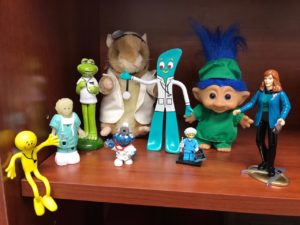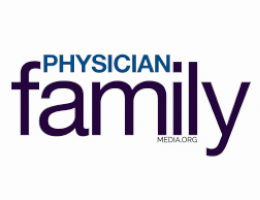The Joy of Writing
by Pamela Camosy, MD

Let’s face it: all healthcare professionals are writers.
We take pen to paper—or fingers to keyboard—many times every day as part of the medical process. First we meet with a patient for a conversation about their symptoms, then perform a physical examination and devise an assessment and plan. The documentation of our interaction is accomplished through our writing: the patient’s medical history becomes his-story or her-story.

If we move beyond the objective medical facts to contemplate how a particular patient’s story affects us, if we begin to see patterns in the ebbs and flows of our careers, or if there is one patient whose story sticks in the memory over time, then we have rich material for creative writing.
In my case, that one memorable patient experience occurred decades ago. On that day I had two patients in the hospital: a dying woman and a young lady in labor with her first child. As I moved up and down in the elevator, the soul-wrenching themes of life and death were inescapable, and at the end of the day, we three women became only two.

Four years ago I sat down to write that story. I simply had to honor the events of that day; what happened to the three of us could not go unnoticed to the world. I did not sit down to write a book, simply that one powerful story, which I called “Passages.” As I wrote, details of that day flooded back to me like so many gifts from heaven: a graceful Charleston accent, azaleas on the windowsill, new parents telling me of the freshly painted baby nursery. As I typed, the lessons that I learned that day were freshly revealed to me. I felt the presence of God in that keyboard.
That creative experience was so rewarding, so revealing, that I started a list of other memories from my medical practice, and I soon had four pages of ideas. Was it possible? Did I really have that much to write about? Apparently so.
My patients entrust me with so much of themselves that I cannot help but feel honored. Within the sanctuary of my clinic or the hospital room, my patients bring me their pain, their problems, their heartaches. They also share their joys, successes, life lessons, and insights. Some tell me secrets that they have not told another soul on this earth.
My dear patients teach me, they motivate me, and sometimes they heal me. Over the years, and reflected in my written stories, I have discovered that within the patient-physician relationship healing energy flows in both directions. In Healer’s Heart you can read of parents who lost their baby to sudden infant death syndrome, yet still had enough room in their hearts to help me in my feelings of inadequacy; of a military veteran who helped me feel closer to my father after his death by telling me details about Vietnam that Dad himself never discussed.

If you are not currently a creative writer, you may have a few questions.
Why should I write?
When I first started creative writing, my goal was not to get published, but to enjoy myself while exploring my soul and spirit as a healer. As my fingers clacked away at the keyboard, as the story of a patient interaction unfolded, I gained insights that I am sure would not have occurred to me otherwise. For example, some patient stories drew me back to my own very specific childhood moments. Others reminded me that I really really enjoy being a physician.

A larger answer to the question “why write?” relates to the importance of telling our stories of healing. As politicians and number-crunchers across the country are busily revising American healthcare, we must add our voices to protect the sanctity of the patient-physician relationship. Write!
What should I write?
Start with just one patient experience that has touched you on a personal level, and write about it. Do not strive for perfect grammar and spelling; just describe what happened and how you felt. Include sights, sounds, even smells, as well as your own reactions. Write!

How can I be a better writer?
I am a big fan of established writers helping those who are starting out. Local literary organizations sponsor valuable workshops led by experienced writers. I joined many of them; their experts helped me to grow in my craft. Now that my own first book is out, I encourage my colleagues to let me help them. Send your comments or questions to me at www.facebook.com/healersheartbook. Write!
Please join me in the pages of my new book, Healer’s Heart: A Family Physician’s Stories of the Heart & Art of Medicine. It is a tribute to the healing power of the patient-physician relationship, and is available on Amazon in print and e-book.
****

Pamela Camosy is a practicing family physician and writer in San Antonio, Texas. After growing up in a military family and traveling across the world, she attended the University of Texas at Austin, where she received a B.A. in biology in 1976. She completed medical school at the University of Texas Health Science Center at San Antonio (UTHSCSA) in1980 and has been practicing family medicine since that time. In addition to her medical practice, Dr. Camosy serves as adjunct Assistant Professor in the Department of Family and Community Medicine at UTHSCSA. In this role, she teaches medical students in her office, in lectures and grand rounds, in free clinics. Her passion is remaining joyful and creative in her profession and encouraging everyone she meets to do the same.

Pamela has been a writer since childhood. As an adult she has published scholarly articles in American Family Physician and The Journal of Family Practice and serves as manuscript reviewer for these journals. In the 1980’s, she wrote a regular bioethics column for The New Catholic Miscellany, South Carolina’s official Catholic newspaper. In 2014, she felt called to return to creative writing pursuits, and has since had poetry and prose published in literary journals including Connective Tissue, Voices de la Luna Literary & Arts Magazine and The Thing Itself. She recently completed Healer’s Heart: A Family Physician’s Stories of the Heart and Art of Medicine, a book that focuses on the healing power of the physician-patient relationship.









